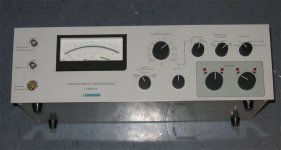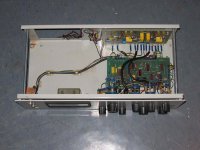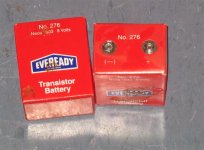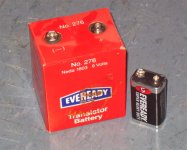I badly want a distortion analyzer and I found this thing a while ago. It is still collecting a lot of dust in a pawn shop and I think I should buy it, even just for heck of it. I looks to be mint condition and I could get for $50.
It is a Radford LDMS2-2 and the meter indicates distortion meaurment to 0.03% full scale. I think it would be a suitable piece of kit for a beginner like me? Made in the UK by, I believe, the same Radford folks that built amplifiers? Did they even sell these things or was it for Radford use internally I wonder?
It runs off two 9 volt batteries! I could change that easily? I guess it was portable but I don't know why.
Does anyone have a manual for it?
Cheers,
Shawn.
It is a Radford LDMS2-2 and the meter indicates distortion meaurment to 0.03% full scale. I think it would be a suitable piece of kit for a beginner like me? Made in the UK by, I believe, the same Radford folks that built amplifiers? Did they even sell these things or was it for Radford use internally I wonder?
It runs off two 9 volt batteries! I could change that easily? I guess it was portable but I don't know why.
Does anyone have a manual for it?
Cheers,
Shawn.
latala said:Radford only ever made high end equipment pick it up its a bargain !
regards Trev
Ps really have enjoyed your crown work
Thanks Trev, the Radford looks great but if it doesn't work I'll need a schematic...perhaps there is one inside?
Still tweaking the DC300A. It should be tip-top very soon.
Shawn.
Radford Oscillator Link ...
Here is a link to a piece of Radford Equipment - a Very Low Distortion Oscillator ...
Link:
http://www.amplifier.cd/Test_Equipment/other/radford.htm
No manual or schematic though ...
Here is a link to a piece of Radford Equipment - a Very Low Distortion Oscillator ...
Link:
http://www.amplifier.cd/Test_Equipment/other/radford.htm
No manual or schematic though ...
Re: Radford Oscillator Link ...
Thanks for the link! I had some corespondance with that chap a while ago when I first saw the Radford a few months back. He directed me to one of the engineers that worked for Radford but unfortunately I never could make contact with the guy.
Thanks for keeping an eye out. Perhaps someone out there does have some info?
Perhaps someone out there does have some info?
Cheers,
Shawn.
torroid88 said:Here is a link to a piece of Radford Equipment - a Very Low Distortion Oscillator ...
Link:
http://www.amplifier.cd/Test_Equipment/other/radford.htm
No manual or schematic though ...
Thanks for the link! I had some corespondance with that chap a while ago when I first saw the Radford a few months back. He directed me to one of the engineers that worked for Radford but unfortunately I never could make contact with the guy.
Thanks for keeping an eye out.
Cheers,
Shawn.
Radford Batteries ...
LINK:
http://www.lowcostbatteries.com/product_p/evr276.htm
Battery Data - These 276 are pretty hefty, so those small ones might last very long ! Good enough for a "dead or alive" test though !
Good Luck !!!
LINK:
http://www.lowcostbatteries.com/product_p/evr276.htm
Battery Data - These 276 are pretty hefty, so those small ones might last very long ! Good enough for a "dead or alive" test though !
Good Luck !!!
Re: Radford Batteries ...
Interesting link as I did not think such a cell was available anymore. If it works well, I'll build a power supply for certain.
Thanks,
Shawn.
torroid88 said:Good enough for a "dead or alive" test though !
Good Luck !!!
Interesting link as I did not think such a cell was available anymore. If it works well, I'll build a power supply for certain.
Thanks,
Shawn.
If that manual also contains the schematics, I would be very interested in seeing a pdf of that manual, as the oscillator appears to be among the very best..........
and Tom - I think you should seriously concider getting those batteries, as they probably plays a rather important role in keeping the noise floor all that way down. ( Rechargeable 9Vs could be another way...)
and Tom - I think you should seriously concider getting those batteries, as they probably plays a rather important role in keeping the noise floor all that way down. ( Rechargeable 9Vs could be another way...)
and completely isolate the charging system, including ground, before connecting the analyser to the circuit under test.AuroraB said:I think you should seriously consider getting those batteries, as they probably plays a rather important role in keeping the noise floor all that way down. ( Rechargeable 9Vs could be another way...)
Maybe a TRS jack plug & socket that prevents insertion of input/output plugs until you've disconnected the charger.
Even the face plate looks worth $50.
I have some equipment that uses a bunch of #246 9V batteries, a bit smaller than your behemoths. Curious, I carefully opened the bottom of the box to see what was inside. Amazingly, there was a little circuit board with the exposed terminals on top, a couple perfectly standard 9V batteries plugged into terminals on the bottom, and a wood spacer to take up the rest of the space! You probably won't be as lucky, but I can now just plug new 9V batteries into mine, which is about 10X cheaper than buying new #246 batteries. I didn't know one could parallel batteries, but if the voltages are matched, it obviously works. Might be a way to run your unit, as it would probably exhaust the normal size batteries very quickly.
- Status
- This old topic is closed. If you want to reopen this topic, contact a moderator using the "Report Post" button.
- Home
- Design & Build
- Equipment & Tools
- RADFORD - Low Distortion Measuring Set



